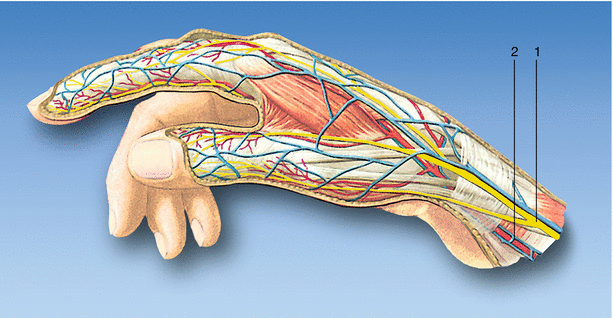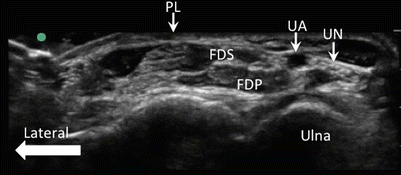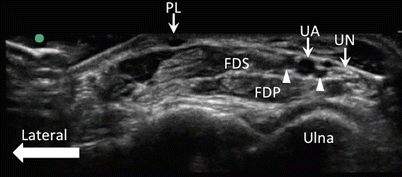Fig. 35.1
Anatomy. (1) Ulnar nerve, (2) median nerve, (3) ulnar artery (Reproduced with permission from Danilo Jankovic)
In the medial distal third of the forearm, about three fingerbreadths proximal to the wrist, the ulnar nerve divides into a dorsal branch (sensory to the dorsal surface of the hand and fingers), a small palmar cutaneous branch to the hypothenar eminence, and a mixed branch—the palmar branch. The latter runs superficially between the tendons of the flexor carpi ulnaris and flexor digitorum superficialis muscle. The ulnar artery lies directly radially, alongside the nerve.
Median Nerve (Fig. 35.1)
The median nerve lies between the tendons of the palmaris longus muscle and the flexor carpi radialis muscle. It runs in the direction of the long axis of the radius. Three fingerbreadths proximal to the wrist, the medial nerve gives rise to a palmar cutaneous branch to the thenar eminence.
Radial Nerve (Fig. 35.2)

Fig. 35.2
Anatomy. (1) Radial nerve (superficial branch), (2) radial artery (Reproduced with permission from Danilo Jankovic)
The superficial branch of the radial nerve runs—together with the radial artery, initially—in the forearm along the medial side of the brachioradialis muscle in the direction of the wrist. About 7–8 cm proximal to the wrist, it crosses under the tendon of the brachioradialis muscle and reaches the extensor side of the forearm. At the level of the wrist, the radial nerve divides into several peripheral branches.
Indications
Surgical
1.
Minor surgical interventions in the innervated area
2.
Supplementation of an incomplete block of the brachial plexus
Diagnostic
Differential diagnosis of painful conditions in the hand
Therapeutic
Carpal tunnel syndrome
Ultrasound-Guided Technique
Ulnar Nerve (Fig. 35.3)

Fig. 35.3
Sonogram of the ulnar nerve just proximal to the carpal tunnel. At this level, the ulnar nerve (UN) is on the ulnar side of the ulnar artery (UA). FDS flexor digitorum superficialis, FDP flexor digitorum profundus, PL palmaris longus (Reproduced with permission from Philip Peng Educational Series)
The patient is in supine position with the forearm supinated. The target is just proximal to the proximal palmar crease. As the injection at the wrist level misses both the palmar cutaneous branch to hypothenar eminence and the dorsal cutaneous branch, this injection will require supplementation of the two cutaneous branches with subcutaneous infiltration. The authors prefer the injection at the elbow level.
For the injection at the wrist level, an ultrasound probe is placed on the ventromedial aspect of the distal forearm. The ulnar nerve is seen on the ulnar side of the ulnar artery. The needle is inserted out-of-plane to the ulnar side of the ulnar artery, which is usually accompanied by one or two veins. Gently releasing the pressure of the probe will reveal the vein, and this maneuver helps to avoid inadvertent venous puncture (Fig. 35.4). A volume of 3 mL of local anesthetic is sufficient. This is followed by subcutaneous infiltration along the ulnar aspect of the wrist (volar and dorsal sides) with 5 mL of local anesthetic.










